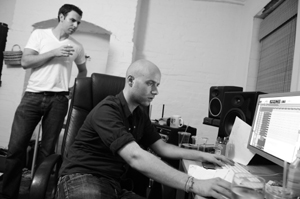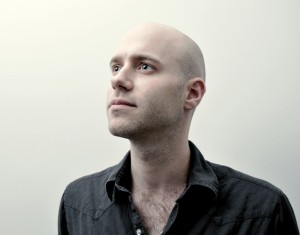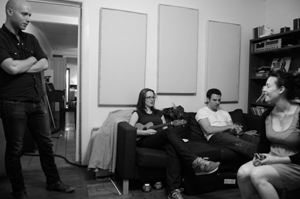Producer Profile: Dan Romer Wins Out with Lelia Broussard, Songwriting…and the Tuba
PARK SLOPE, BROOKLYN: Fluency on the tuba is not at the top of Dan Romer’s resume, but dig deeply enough into his profile and you’ll find he’s got it down. That, and a number of other interconnecting abilities that make this Brooklyn-based producer/songwriter/mixer/arranger a man in demand.
The diverse skill set on musical instruments – Romer can hit the stage on accordion, guitar, Mellotron, drum machines and percussion, in addition to tuba – reflects his agility in his Park Slope studio, home of Drawing Number One Productions. There, he’s tracked, mixed and collaborated with songwriters that are stepping up and out, scoring big with singles and synch licensing: a list that includes Ingrid Michealson, Jenny Owen Youngs, Ian Axel, and April Smith, among others.
Meanwhile, his work with Lelia Broussard has been a big part of the smart songstresses’ fast and recent rise. One of two finalists in Rolling Stone’s “Do You Wanna Be a Rock Star?” competition, Broussard has gone deep into the contest armed with the arresting album Masquerade that Romer produced. Equal parts sage, savage and sweet, Masquerade is a record real enough to cut right through the clutter — precisely why you should expect to see Broussard on the cover of Rolling Stone this August.
Smoking a cigarette on the stoop while his latest charge, Cara Salimando, looked through lyrics inside Drawing Number One, Romer made it clear that production, songwriting, engineering and raw musical instinct can successfully intersect.
On your Website, you seem pretty uninterested in making a big deal out of your studio, gear or the tools that you use. Why is that?
The most obvious answer is, I don’t really think it’s about the gear. It’s about the work. I don’t use the most expensive equipment in the world. I personally feel the way that home recording works is: If you’re not going to be doing drums at your place, really what you need more than anything else is a good-sounding space and a really good stereo chain.
I use a mic that I love, a preamp that I love, HD converters, and that kind of chain is something you’d see in a super professional recording studio.
What mic and pre is that specifically?
The mic is a Pearlman TM 1. It’s hand-built by a guy named Dave Pearlman in L.A. He’s a total sweetheart — I’ve left my mic on too long and blown out the tubes, and he’s sent out new ones right away. It’s in the U 47 vein. If I can, I prefer to go with mics where actual people are building them — you get more attention from them.
The mic pre is the Portico 5012. It’s a somewhat mellow preamp. I like getting the sound super-aggressive at the source, and then using my pres to mellow it out. The Portico, when you press down the “Silk” button, it makes more use of the transformers. When you’re recording something like percussion, you can hit it and it calms it down a little bit. It’s like having two preamps in one — it’s a fantastic feature.
What are the spaces you have available to you in your home studio?

Inside the HQ of Drawing Number One, with drummer Elliot Jacobson looking on. (Photo Credit: Deborah Lopez)
I have closet that I turned into a vocal booth. I padded every wall down with fiberglass, put a rug down, and left the ceiling open so I could have one reflection. I also have a humongous basement. What I did there is got a bunch of packing blankets and killed reflections until I had no slapback, then left it at that. So it’s as natural as possible.
When I record drum sounds there, I set up room mics near the heating ducts and get a whole lot of sustain. But I prefer a jagged live room with no slapback to a very well-treated wood panel room.
You seem to get along with some determined female singer/songwriters. In addition to Lelia Broussard, I see on your discography Ingrid Michaelson, Jenny Owen Youngs, Bess Rogers, for starters. What’s their appeal to you as clients, and why do they seem to like you back?
When you’re in high school, it’s very common for guys to be in hardcore, punk and rock bands, and very common for girls to be playing an instrument and singing alone unaccompanied. That has nothing to do with abilities or mindframe of either gender, it has to do with where society pushes them.
So when I got to college at SUNY Purchase, the situation there was that the guys had been playing with bands since they were 14 or 15 years old, while many of the female singer/songwriters had very little experience in bands. SUNY Purchase has some pretty distinguished alumni by the way — Regina Spektor, Moby, Langhorne Slim, Dan Deacon, Jenny Owen Youngs, the Presidents of the United States of America. It’s a left-of-center pop music school.
Jenny Owen Youngs and I were really close friends in college. I had never produced a record before, but I somehow convinced her that I knew how to do that! She allowed me to record her first album, which she released independently and then got picked up by Nettwerk unchanged — they kept my mixes and the mastering.
More often than not, I’ve noticed guys have full bands that they’re already in, in which all the band members have artistic and financial stake, while it’s a lot more common for ladies to be solo artists. So it gives me an opportunity while working with them to put a band together and get the sound with them, rather than working with the sound that already exists between a bunch of people. Plus, the artists I’ve worked with that people know the best are Jenny Owen Youngs and Ingrid Michaelson. So I get inquiries from mostly female artists.
Beyond simply being a producer/engineer, you also collaborate with many of these artists as a songwriter. How does that work out?
I think being available as a co-songwriter as well introduces a specialness to the project. Instead of you [the artist] coming in with songs and just having them recorded, you’re making a whole new baby. It becomes a whole different project that couldn’t have happened otherwise.
When I’m writing with an artist, I try to get them out of their box. For instance with Cara Salimando, it’s a case of me saying, “You’ve written a lot of beautiful down tempo songs. Now let’s write some punk songs.” So when I sit down and start playing a guitar part unlike anything they’ve ever used, it’s an exciting place – ideas they’ve never tried before take them out of their comfort zone.
With an artist, I look at their top four or five songs they’re showing on the Internet. I’ll say, “What’s the same among all these songs?” Rhythms, chord progressions? Do they never use a two-chord? Or do they always change their chords on the down beat, or only have offbeat chord progressions? When I’m arranging, I’ll say, “What if we slow this song by 20 BPM? What happens if we don’t have the guitar, what if it’s just drums, bass and long piano chords?”
I try to get them going in another direction, not because what they’re doing isn’t great, but to get them out of their comfort zone so they get some ideas they haven’t thought of before.
That sounds stimulating. But what if an artist doesn’t want to leave that place that’s so comfy for them?
It’s happened before: An artist didn’t want to go out of their comfort zone, and it ended up not working. We did three days of writing and that was it.
As I understand it, Lelia started out as just a one-or two-song project. Why did it blossom into a full album?
She was going to record an acoustic EP out in L.A. We knew each other via some mutual friends, we hung out — I’d seen her live and really liked her.
I was playing a show with Ingrid out in L.A. and Lelia told me she was recording an acoustic EP. I told her it might be cool if we did a string quartet arrangement for the four songs, just to make them something special. I gifted her the album Chelsea Girl by Nico, and said, “Check out these arrangements. It’s pretty much acoustic guitar and a string quartet.” She called me back and said, “I love this record. Let me send you the songs I want to do.”
After some back and forth, and deciding the strings were a terrible idea and we should just do full band arrangements, Lelia and I wound up recording five songs in two weeks – “Spiderwebs,” “Rosey,” “Hipster Bitch,” “You’re Not Fooling Anyone,” and “Shoot for the Moon.” She went back to L.A., and then called me and said, “Can we just do another five, and make it a whole record?”
Couldn’t ask for a better introduction. What happened when she returned to NYC and your studio?
Having us both so happy with the recordings as they were — when she came back, we knew we had to one-up ourselves. Which was daunting and exciting. You always want to do better. So we did “Armor on my Heart,” “Masquerade,” “Something True,” “Satellite,” and “Heart Collectors.” It’s all the same players, it’s all the same gear, the same room, so it sounds like a cohesive record.
Together those became the album Masquerade, which came out late last year. The two singles from the record are “Masquerade” and “Satellite,” and those two come from the second batch.
What was your approach to capturing her sound, especially the all-important vocal?
The thing that I wanted to bring out in her music, more than anything else was the guttural nature of it.
When you listen to her chord progressions, which often have jazz qualities in them, an obvious vision a producer could have is a jazzy rock kind of thing, in a smooth realm. But her vocal isn’t just this big beautiful smooth thing – it’s also got this guttural thing going on, and that’s what I wanted to focus on.
It’s a very basementy-sounding record in a lot of ways, and we went for that sound to bring out this quality that I want to keep saying: guttural. She’s such an amazing singer — there’s not a stitch of Auto-tune on the entire record. The vocal chain was the TM 1 and the Neve Portico. We did a lot of takes and picked the ones we liked the best.
For an album like this, what are the strengths and limitations of working in your method, which is totally in the box?

Lelia Broussard’s collab with Romer has gotten her THIS CLOSE to the Rolling Stone championship. (Photo credit: Shervin Lainez)
The strengths are recall speed, and also having as many instances of a hardware emulation as you want. For example, I’m smashing the room mics with an 1176 clone. I might have four tracks of toms, laid on top of each other, each with four room mics up and I use an 1176 on every room mic. So we’re talking — just for tom overdubs — sixteen 1176’s.
I know that there’s a certain magic that hardware has that software doesn’t, but price and convenience wins out in this area right now. I do believe this whole concept of hardware having any kinds of strength over software is going to be gone in ten years. Technology exponentially improves. How much better the plugins are now then 10 years ago is insane — the CLA 1176 plugin is just worlds ahead of any 1176 emulator from 10 years ago.
What’s the overall setup that all those emulations are stacked up in?
I’m running a newish desktop Mac, Pro Tools HD9, a 192 I/O, Focal monitors, and a pair of Events for reference, and Sennheiser HD650 headphones to check the headphone mix.
My preamps are the Portico, an API 3124, the Grace M101 — that pairs great with a Royer because it’s so transparent — and a Focusrite ISA 828, which I use when I need extra channels when I record drums.
My mics are the Pearlman TM 1, a pair of Mojave MA-200s, a Royer 121, a pair of KM-69s from Mercernary Audio, a slew of SM57s, a pair of Sennheiser 421s, Electro Voice RE20, AKG D112, Shure Beta 52 and a pair of Audio Technica 4033s. All the room sounds for drums on Lelia’s record are 4033s.
You and Lelia have done a lot of hard work together. Now it seems to be paying off, if approval from Rolling Stone and its audience still counts for something – which we think it does. Why do you think she’s made it down to the final two in the Rolling Stone “Rock Star” contest?
I feel like a lot of it has to do with the songs and the songwriting quality. She has great songs, great style, and we made a really special record together. She’s got a large fan base that’s behind her in this contest.
I know it’s an old rhetoric – “if the songs aren’t good you can’t do anything with the music” – but it’s true. She came with lot of really great songs, and we were able to transform them into recordings we both really love.
— David Weiss
Please note: When you buy products through links on this page, we may earn an affiliate commission.









jake antelis
May 27, 2011 at 3:39 am (14 years ago)awesome!